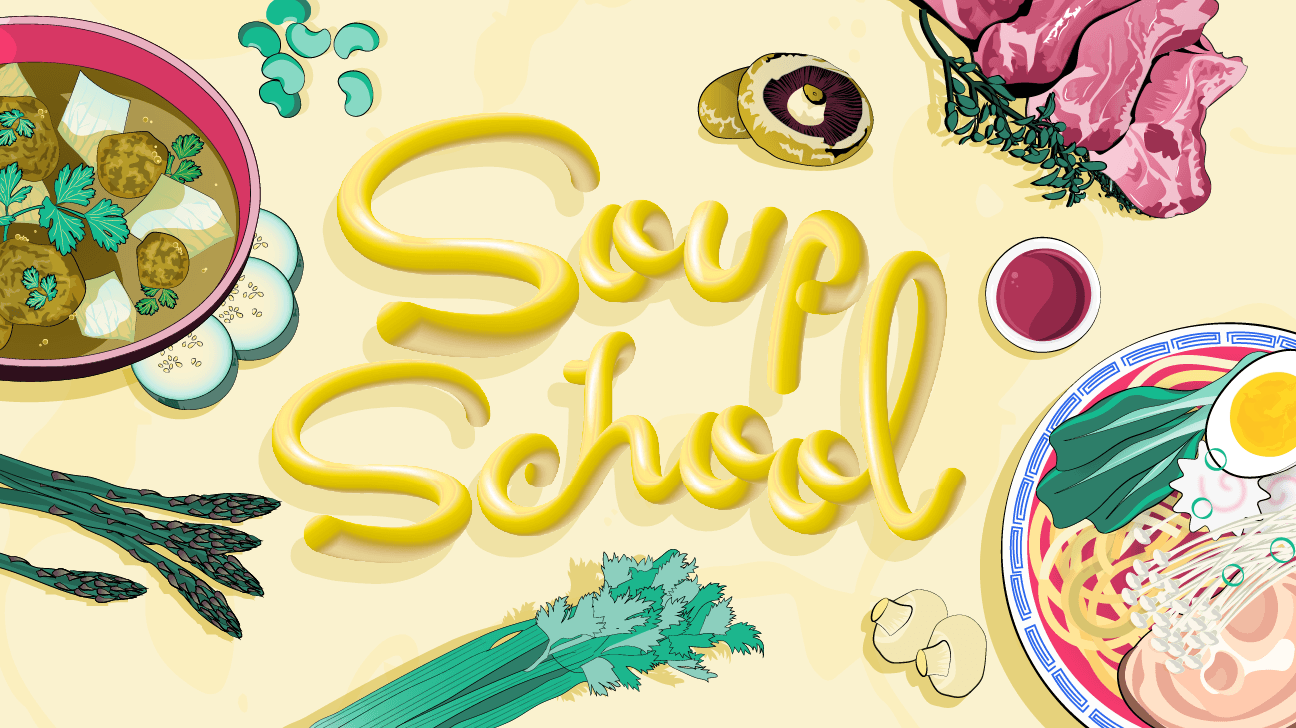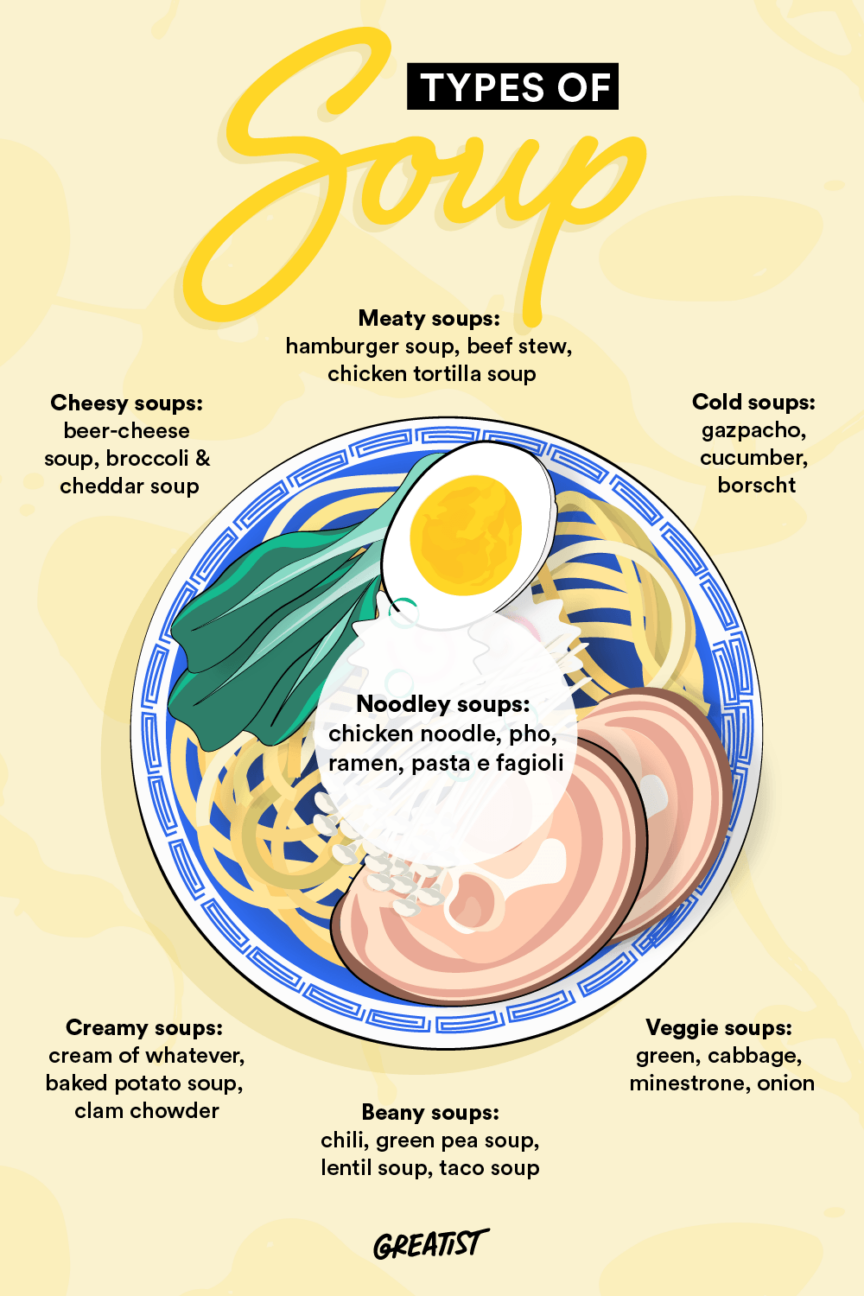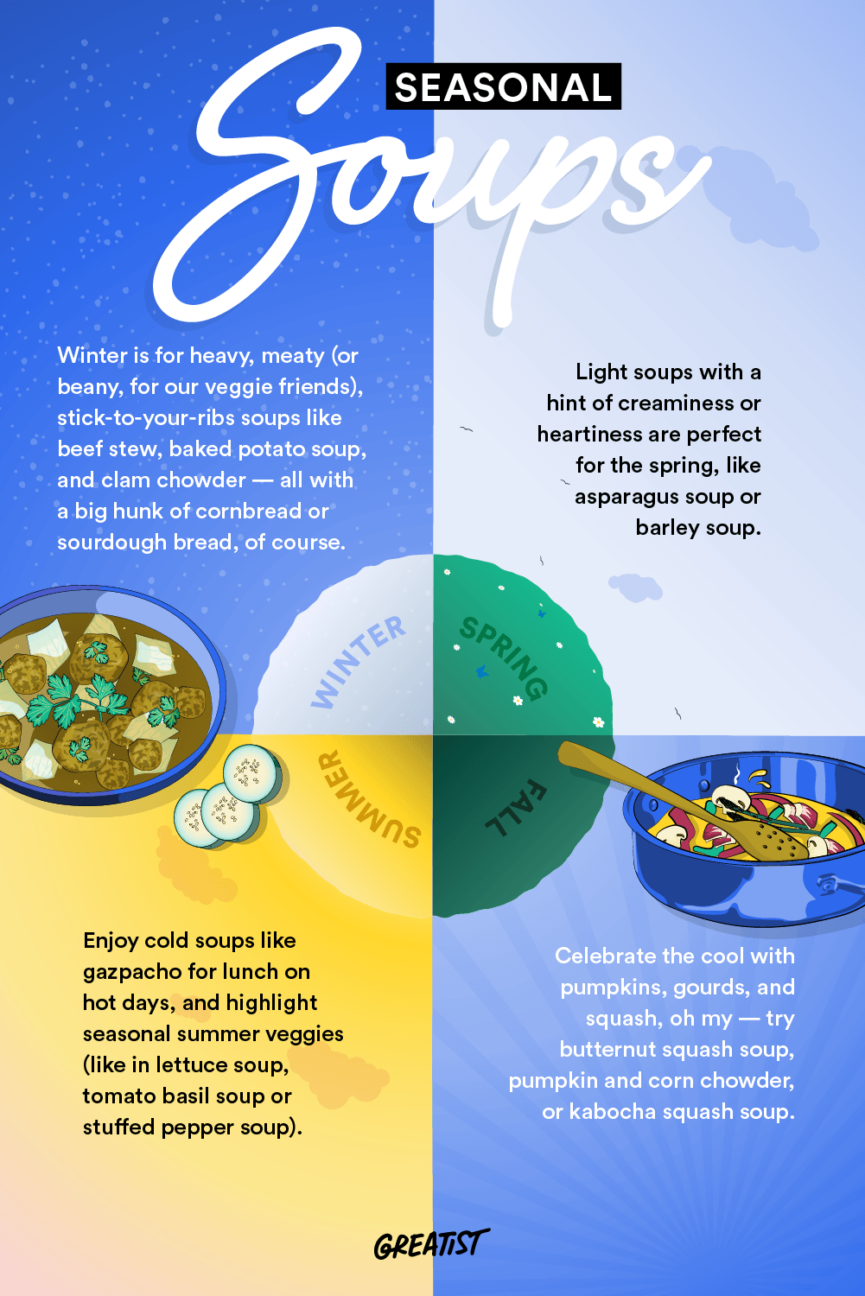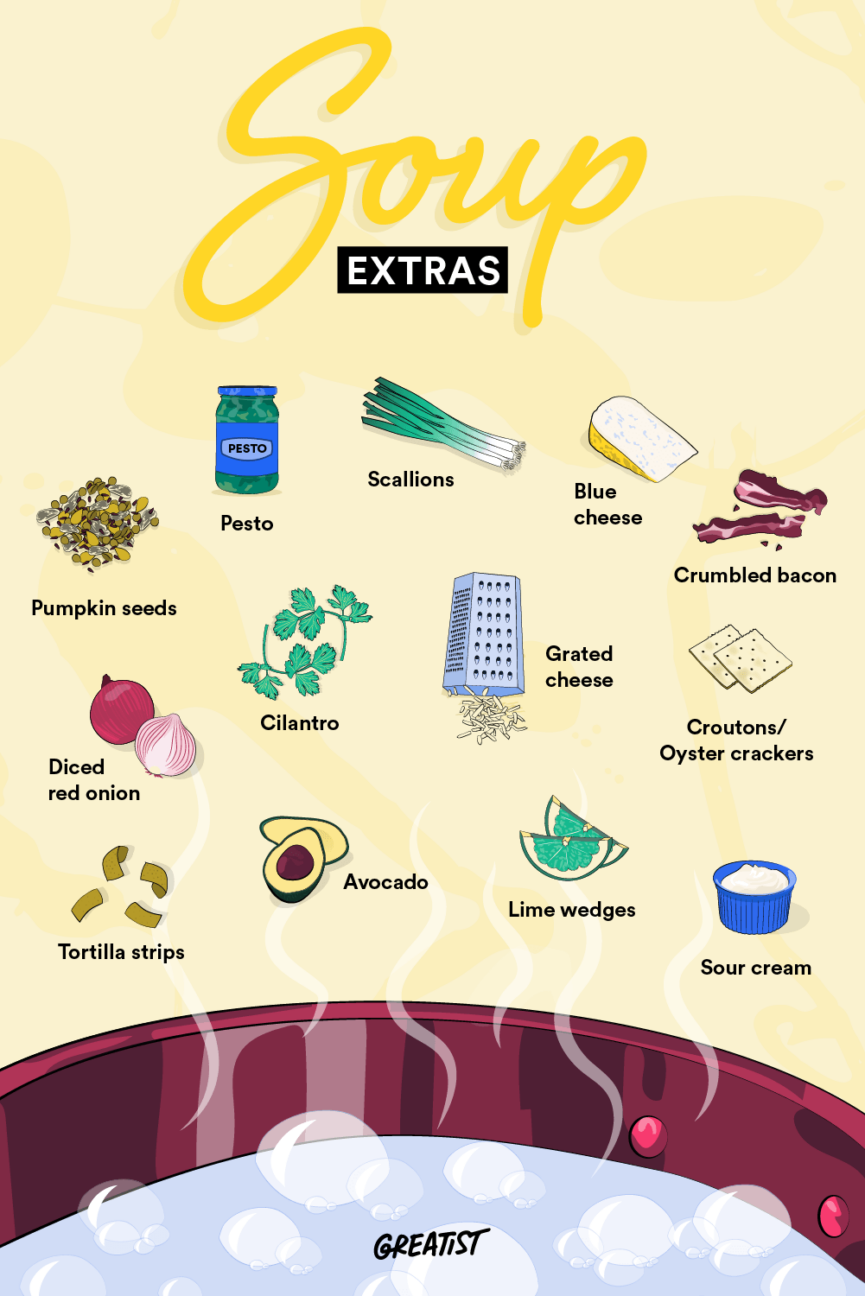
Welcome to Soup School!
Soup is truly the blank canvas of the cooking world. It’s cozy, comfy, sentimental — like grandma’s chicken noodle when you’ve got the sniffles. It’s elegant, like a smooth, fresh gazpacho in a restaurant with a dress code. Healthy, cause you can load it with veggies (or, alternatively, not at all healthy but good-for-the-soul). Easy and inexpensive, like the ramen noodle soup that held you down through your college years, or complex and luxurious like a traditional ramen bowl piled high with toppings.
We created Soup School to expand the boundaries of your soup skills (and ours tbh) in just a few short hours each week. It’s got soup inspo for all tastes, diets, budgets, lifestyles, and skill levels — from the “I usually open a can” types (holla, Campbell’s!) to the “cooking my way through Ottolenghi” types.
Soup basics
In this workshop, you’ll learn all about soup types, the supplies and equipment you’ll need, and soup-making hacks. And trust and believe, there will be recipes. Soooo many recipes.
It’s gonna be a ton of fun, and by the end of Soup School you’ll know all the basics of soup-making — so you’ll be able to DIY your dinner, no recipe required.
How it works
Here’s a quick rundown of how Soup School works.
- Time commitment: LOW. If you’ve got an hour a day on the weekends, then you’ve got time to make some killer soup. But there’s no roll call at Soup School — so you do you.
- Skill level needed: LOW. If you can chop, stir, and turn your oven on, you’re golden (just like the chicken broth you’re gonna learn to make next week).
- Essential gear: cutting board, knife, large pot, ladle, stirring spoon, blender, strainer, measuring cups and spoons
- Optional gear: food processor, immersion blender, garlic press, microplane, skimmer, grater, masher
- Recipes: We will load you up with TONS.
Whenever you’re ready, work your way through reading this post and the other soup-er educational posts we’ve linked out to.
Next, choose the soups you want to learn inside and out. We recommend choosing several drastically different soups so you’ll learn lots of diff methods. For example: baked potato soup, pho, and chicken tortilla soup.
Then, for the next several weeks (or indefinitely if you really like soup), follow our Weekend Calendar below, which will walk you through planning, prepping, cooking, eating, storing, and reheating your soup.
Now, let’s make soup happen.
Is soup really healthy?
Um, yes, because it’s made with love, and according to a 2021 study we just made up, love cancels out all the heavy cream calories in our fave soups.
But seriously, soup is mostly pretty healthy. And the best part about making it at home is that you can make it even healthier if you’d like. Use low-sodium chicken broth, or don’t add any salt to your homemade broth. Swap out heavy cream for half-and-half or milk. Add lots of extra veggies. (Hint: extra greens work well in almost any kind of soup.)
For more on soup and health, check out: Is Soup Healthy? Yes, It’s Mostly Souper Duper.
Types of soup
There are so many ways to categorize soup. For all you food geeks out there (we feel ya), the old-school classification of soup types is actually based on soup thickness.
Alternatively, you could categorize soups by their most identifying trait, like we do for the purposes of Soup School:

- Veggie soups: green, cabbage, minestrone, onion
- Cheesy soups: beer-cheese soup, broccoli and cheddar soup
- Noodley soups: chicken noodle, pho, ramen, pasta e fagioli
- Meaty soups: hamburger soup, beef stew, chicken tortilla soup
- Cold soups: gazpacho, cucumber, borscht
- Creamy soups: cream of fill-in-the-blank, clam chowder, baked potato soup
- Beany soups: chili, green pea soup, lentil soup, taco soup
Tag yourself. We’re baked potato soup because we’re chunky and baked!
And speaking of baked, there are even bread-topped supersouper soups that make us want ALL the carbs.
Soup by the seasons
Despite being often relegated to fall or winter, soup is truly a year-round treat. Don’t believe us? Here’s a quick soup by the seasons primer.

- Spring. Light soups with a hint of creaminess or heartiness are perfect for the spring, like asparagus soup or barley soup.
- Summer. Enjoy cold soups like gazpacho for lunch on hot days, and highlight seasonal summer veggies (like in lettuce soup, tomato basil soup or stuffed pepper soup).
- Fall. Celebrate the cool with pumpkins, gourds, and squash, oh my — try butternut squash soup, pumpkin and corn chowder, or kabocha squash soup.
- Winter. Winter is for heavy, meaty (or beany, for our veggie friends), stick-to-your-ribs soups like beef stew, baked potato soup, and clam chowder — all with a big hunk of cornbread or sourdough bread, of course.
Pros and cons of store-bought vs. homemade soup
There’s levels to this soup. Here are the pros and cons of the different types of soup you can buy or make:
| Pros | Cons | |
| Canned soup | Convenient Inexpensive Quick and easy |
Highly processed Taste is meh Not fresh |
| Storebought soup | Fresher than canned May be made with local/seasonal veggies Time-saving |
Can’t control ingredients/nutrition Likely more expensive than homemade Limited flavors |
| Homemade soup | Total control over ingredients/nutrition Fresh as it gets Totally suited to your tastes/prefs |
Time-consuming Slight learning curve More shopping/planning involved |
Getting started
Now, here’s your essential soup starter kit with ALLL in the information you’re gonna need to start simmering.
Soup Gear
Part of the beauty of soup making is that you literally need 2 pieces of essential equipment: a large pot and a knife. Other kitchen basics will come in handy though: a cutting board, ladle, stirring spoon, and measuring cups and spoons. Plus, depending on the type of soup you’re making, you may need to bring out the blender and/or a strainer.
Broth Basics
A good broth is essential for a good soup, so it’s something you really wanna know inside and out — even if you end up buying premade broth — and there’s totes nothing wrong with that. In fact, you can check out our roundup of best bouillon cubes and soup starters. In addition, Certified Food Scientist, Jessica Gavin, provides a terrific summary of store-bought broth options, including:
- Bouillon cubes or granules
- Stock bases
- Single-strength stocks and broths
Alternately, you can choose to make your own stock, which isn’t hard. These tips are helpful if you’re a newb.
Soup recipes
And now for the best part: the recipes! Here’s a basic collection of soups from some of our favorite food bloggers, but feel free to dust off those old cookbooks on your bookshelf or go scouring the internet for recipes that suit your tastes.
Greatist Recipe Collections
- 15 Creamy Soup Recipes for Warding Off Cold Winter Weather
- 15 Vegan Soup Recipes That Prove You Don’t Need Dairy or Meat for Flavor
- 19 Whole30 Soup Recipes That Make January Way More Tolerable
- 19 Breakfast Soups (Yes, Really!) for Cold Mornings
- 21 Chilled Soups That Are So Hot Right Now
- 19 Healthy Soups to Make Weight Loss Taste Boss
- 21 Noodle Soup Recipes That Prove It’s Not All About Chicken
- 23 Miso Recipes So You Can Finally Use That Entire Jar (and Not Just for Soup)
- 5-Ingredient Fall Soups That Don’t Require Hours of Chopping
- 9 Soups to Meal-Prep Now That It’s Chilly Out and Salads Aren’t Cutting It
- 13 Keto Soups That Skip the Carbs but Not the Comfort
Recipes by Type
- Veggie soups: wild rice soup, vegetable soup
- Vegan soups: lettuce soup, minestrone
- Creamy soups: baked potato soup, clam chowder
- Bean soups: 15 bean soup, ham and bean soup
- Noodle soups: chicken noodle soup, ramen
- Cheesy soups: beer cheese soup, broccoli cheddar soup
- Meaty soups: beef stew, chili, chicken tortilla soup
- Cold soups: gazpacho, borscht
- Paleo soups: cabbage roll soup, chicken pot pie soup
- Keto soups: stuffed pepper soup, chicken tortilla soup
- International soups: harira, maafe
All right: we’ve got our equipment, we’re up to our gills in broth, and we’re equipped with ALL recipes. It’s time to get cooking!
To make it simple, do your soup cookery on the weekend, and then you’ll have something delicious to sip and slurp on all week long.
Day 1: plan and prep
Day 1 is all about making the cooking process as easy and effortless as possible. Here are some things you’ll want to accomplish on prep day.
- Plan. Decide on the soup you want to cook. Check!
- Shop. Hit the grocery store, farmer’s market, or Instacart and get the ingredients you’ll need.
- Prep. Here’s the prep you’ll be able to knock out a day ahead of time.
- Broth. If you didn’t get store-bought broth, today’s the day to whip up a batch or dig into your freezer to pull out the homemade broth you’ve been saving for such a time as this. No broth? No problem. Although the flavors won’t be as complex, you can use a bouillion cube, broth base, or even well-seasoned water.
- Veggies. Let’s mise en place. It’s French for prepping your ingredients in advance. You know how on cooking shows all of the ingredients are divvied up in the correct amount in cute little bowls and ramekins? That’s mise en place, and it’s awesome — although there are some more dish-efficient ways to go about it. While dry herbs, spices, and seasonings aren’t a big deal to measure out on the big day, the most time consuming parts of soup-making tend to be related to veggie prep. So wash that produce, and peel, chop, slice, and grate to your heart’s desire. Then you can put it all in the fridge so it’s ready to go the next day. Note: raw cut potatoes brown quickly, so save your potato prep for the day you make your soup.
- Meats. The biggie is making sure your meat is out of the freezer and thawed. You’ll also want to trim any excess fat (although we recommend leaving it on for the flavor), and cut the meat down to bite size pieces if it’s still in big hunk o’ meat form.
- Plant proteins. Like meats, you’ll want to make sure they’re out of the freezer and thawing the night before in the case of plant-based meats. If you’re using dried beans in your recipe, start soaking them the night before you cook. And if you’re using canned beans, don’t worry — we are too.
Day 2: cook and enjoy!
It’s time to cook! Follow the recipe instructions to whip up your soup creation. With no recipe, the steps to soup-making generally go something like this for a very basic meat and veggie soup:
- Sear the meat
- Cook down the aromatics (garlic, onions, shallots)
- Add other vegetables and meats along with herbs and spices
- Cover all ingredients with broth and simmer until ready to eat
You can follow this general framework to make your own soups after you’ve graduated Soup School, although it’s a good idea to follow a recipe the first several times to get a feel for how it works.
Storing soup
Soup can be kept in your fridge for up to 5-7 days if it’s kept in an airtight container, but most soups freeze exceptionally well too.
We recommend freezing soup in gallon-sized food storage bags (there are tons of reusable, eco-friendly silicon options available these days) laying horizontally. After it’s fully frozen, you’ve got a solid sheet of soup that’s easy to store in your freezer without taking up too much space. You can keep soup in the freezer for up to 3-6 months.
Soup garnishes, dippers, and extras
Extras make soup FUN. Here are our favorites, but just know that if you like any food, you can probably put it on or in soup with great results.

- Don’t forget the dippables. Crackers, crusty bread, tortilla chips, potato chips, French fries, celery sticks…. the dippabilities are endless.
- Garnish with grandeur. Toppings and garnishes are arguably one of the best parts of a good bowl of soup. Keep some fresh herbs, grated cheese, diced onion, roasted nuts, avo, sour cream, hot sauce, crumbled bacon, green onions, jalapenos, and fresh lemons and limes on hand to solve most soup condiment conundrums.
- Turn your cans into “I CAN’T EVENs.” Canned soups tend to be a little sad, even on their best days. Fresh herbs can go a long way to liven up their flavors, and cloying cream soups from a can are awakened with the addition of a tiny bit of acid like fresh lemon or lime juice, or vinegar.
- Make soup the star at your next shindig. Soups that are too good not to share serve as excellent centerpieces for a charcuterie board, surrounded by all kinds of yummy things like grilled cheese sandwiches and breadsticks for dipping, and fresh fruits to provide a nice sweet contrast.
Thanks for joining us for Soup School! We hope we’ve inspired you to grab a stockpot and get cookin’ — and we hope we’ve made it easy to up your soup game. Now: ready, set, sluuuuuurp…

0 Commentaires